Big Spell Mage: A Control Archetype for the Kobolds and Catacombs Era
When Blizzard banished Reno Jackson to Wild, Control Mage players lost a key tool in their quest to a late-game win condition. Though abundant removal spells help mitigate damage, it can still be difficult to stave off lethal pressure and trigger your transformation into Frost Lich Jaina—especially in a meta shaped by Patches the Pirate.
A few cards have helped. Tar Creeper, for example, often trades with two or more enemy minions in the early game. Kazakus is always a source of comfort, his build-your-own spell effect providing you a situational response to whatever type of board state has developed by turn four. And of course in the late-game, Frost Lich Jaina not only heals you over time, but generates perpetual value with her hero power, which can simply fatigue opponents into submission.
But rather than introduce powerful healing spells or more early game removal spells, Blizzard pushed an entirely new archetype: the Big Spell Mage. The reasoning for this seems clear - If they introduced healing or burn spells, they would incentivize more of the run-of-the-mill styles of play. Also, it’s just a lot of fun to play spells with awesome effects. It’s even more fun when you’re rewarded for building a deck around the most powerful spells in the game.
Big Spell Mage’s objective is relatively straightforward: stall until turn five, after which you use your deck’s abundance of removal—again, and again, and again—until given the opportunity to play our win conditions: Medivh, the Guardian, Frost Lich Jaina, and the new Dragoncaller Alanna. Control match-ups often grind into near-fatigue, while many aggro opponents will concede if you manage to stabilize going into turns six and seven.
Kobolds and Catacombs and Fire Dragons
Many cards from the Kobolds and Catacombs expansion—Dragoncaller Alanna, Arcane Tyrant, Spiteful Summoner, Dragon's Fury, Raven Familiar, and Arcane Artificer—made Blizzard’s hopes for a new archetype clear from the outset. The new legendary minion Dragoncaller Alanna might be the flashiest of all, summoning an army of 5/5 Fire Dragons, one for each 5-or-more-mana spell you cast. This provides yet another expensive win condition for Control Mages, one geared specifically toward this archetype. Arcane Tyrant rewards players for playing expensive spells with a free 4/4 minion. This is a powerful tempo play in Mage especially, where it’s now possible to not only wipe an opposing board of four-health minions with Flamestrike, but to also provide a threat of your own—all on turn seven. It’s an Elemental, too, which synergizes with Jaina. Spiteful Summoner makes playing Pyroblast tempting for obvious reasons, though relying on RNG may not be the most reliable of strategies.
The smaller minions help make this archetype viable, offering means for card draw and healing. Raven Familiar is pretty good (not quite an Arcanologist), but downright necessary in a deck that can’t afford to run Arcane Intellect. Meanwhile, Arcane Artificer is a deceptively good card, providing tons of armor over consecutive turns and at least a little in a pinch. Finally, the new Dragon's Fury finally gives Mage an AoE spell in the five-mana slot. It’s a good one, operating in a deck like this as a five-mana Flamestrike at the very least. The fact that it injures one’s own minions is usually irrelevant, considering we need only survive until we find the opportunity and mana to use expensive win conditions.
|
|
||
|---|---|---|
Minion (19)
|
Ability (10)
|
Playable Hero (1) |
| Loading Collection | ||
This is the structure of Kibler’s Big Spell Mage deck, at least. The synergies continue in his list: Medivh, the Guardian can generate powerful minions, while Tar Creeper and Pyros pull double weight as Elementals that gain lifesteal with Jaina. Acolyte of Pain for draw. Doomsayer to stall early on or pair with Blizzard. For a better chance against aggro decks, the most recent versions of the deck toss the two Polymorph for a Prince Valanar and Ice Block.
In general, mulligan for Raven Familiar, Acolyte of Pain, Tar Creeper, and Doomsayer—especially the last two if you suspect you are facing aggro. The meta seems to change every day, but at the time of this writing, the so-called Cube Warlock and Highlander Priest are dominating the standard format. Big Spell Mage doesn’t fare well against them, but you can tech in a Dirty Rat to steal a win or two against the Priests. If you are dead-set on playing a variant of Control Mage in this particular meta, it might be wise to counter them with Quest Mage. Against Dragon Priest and Aggro Paladin, two other powerful and popular decks, Big Spell Mage does pretty well, though winning the aggro matchup depends a lot on the strength of your opening hand. Having Doomsayer to reset the board can win the game, allowing you the time to stall and reach that devastating Dragon's Fury on turn five.
Though it doesn’t compete with the power of some decks on the Standard ladder at the moment, players can (and should) fire up Big Spell Mage for the sheer fun of it. Besides, it’s early in the life of the Kobolds and Catacombs meta, shifting what seems like every other day. When (or if) the popular combo decks fall out of the meta, that might be the time to bring Dragoncaller Alanna out to play.
Blizzard’s overt nudge toward the Big Spell archetype seemed before the expansion’s release to be a gimmick. It has so far proved itself at least a fun gimmick, and at best a board-dominant deck to fear when Patches the Pirate and Raza the Chained cycle to Wild. Until then, here's hoping you pull a Pyroblast and Y'Shaarj, Rage Unbound from Spiteful Summoner.
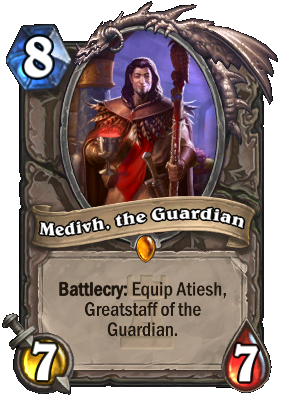
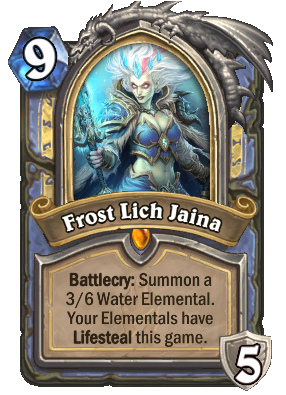
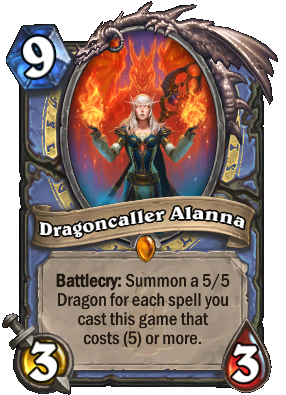
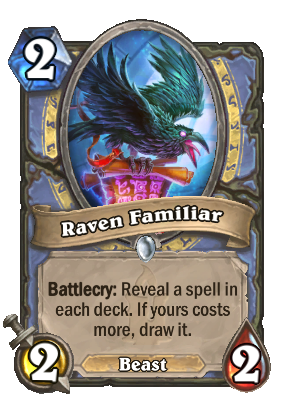
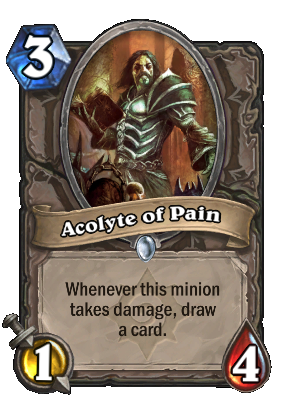
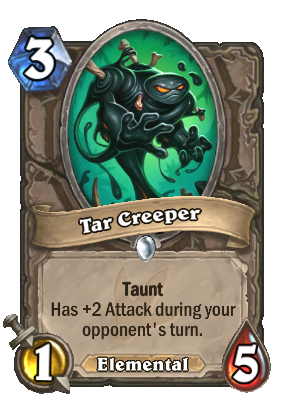
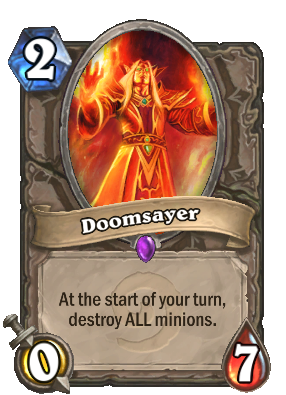


-
View User Profile
-
Send Message
Posted Dec 20, 2017 (Kobolds Patch)the concept is fun XD i use it (with heavy modification) and it goes really well
-
View User Profile
-
Send Message
Posted Dec 18, 2017 (Kobolds Patch)I really like to play this deck since I saw it on twitch. Great mana-curve at turn 5 and lot of answers before. Nice! Love it <3
-
View User Profile
-
Send Message
Posted Dec 18, 2017 (Kobolds Patch)It's really annoying just how many Epics are needed to play any decent control deck. I think this is the #1 reason there are so many aggro decks on ladder. Unless you are willing to invest hundreds on the game you can only realistically build aggro decks.
-
View User Profile
-
Send Message
Posted Dec 18, 2017 (Kobolds Patch)I can kinda relate to this since I was a free to player but the core set of mage is one of the best for control and you can have decent success just crafting 2x doom sayers. Normally tough in card games control decks are generally the most expensive ones
-
View User Profile
-
Send Message
Posted Dec 18, 2017 (Kobolds Patch)I like how one of the conditions of playing this deck is basically doing nothing for 5 turns and then hoping to have a play
-
View User Profile
-
Send Message
Posted Dec 18, 2017 (Kobolds Patch)Somehow have more luck running plated beetles than Iceblook package and or Kabal Courier that is hit and miss card
-
View User Profile
-
Send Message
Posted Dec 17, 2017 (Kobolds Patch)Nice deck, as someone else already said I would add 2xiceblocks and 2xarcanologist instead of spiteful summoner and tar creeper, works for me. The deck is hella fun in both versions! Remember to use the arcane artificer with care, he is KEY to survive: I reached 30+ armor with it, and combined with the iceblocks grants you the time to fetch your cards. The deck infact suffers a lack of consistent card draw (arcane intellect) to allow the "big spell" sinergy. Your new card draw engines are 2xarcanologists, 2xravens and 2xacolytes. Have fun!
-
View User Profile
-
Send Message
Posted Dec 17, 2017 (Kobolds Patch)Na, it's not good going without ice blocks and at least a tome in this deck. Doesn't need spiteful summoners, creepers, even flamestrike. They're all cutable fat off the steak. Who made this deck up?
-
View User Profile
-
Send Message
Posted Dec 17, 2017 (Kobolds Patch)does fine without ice blocks - might need a tome. control mage doesn't always need ice blocks, and if you get a block in a joust, you're screwed usually
-
View User Profile
-
Send Message
Posted Dec 17, 2017 (Kobolds Patch)It's a bummer that Priest is so prevalent right now, because I feel like this deck has a favorable match-up against pretty much any deck EXCEPT Priest... And I'll I see on ladder is Priest after Priest after Priest after....
-
View User Profile
-
Send Message
Posted Dec 17, 2017 (Kobolds Patch)Big spell mage concept is fun, but warlock's Rin totally destroys this deck :)
-
View User Profile
-
Send Message
Posted Dec 17, 2017 (Kobolds Patch)That deck is strong I'd admit that. However, as soon as people start to tech/put in (in my opinion, very hard counter and viable vs other decks as well) Spellbreaker life gets easier. It's not a hit and win card, but I would lie if I didn't admit it has single handily won games vs Warlock for me.
Silence effects has fallen in and out in usage but as for now I think it Silence is at it's strongest position in the history of Hearthstone.
-
View User Profile
-
Send Message
Posted Dec 17, 2017 (Kobolds Patch)smart players play Rin and kill it on the same turn, also if you play doomsayer they put Rin right away
-
View User Profile
-
Send Message
Posted Dec 17, 2017 (Kobolds Patch)Rin? I never play it against Rin. If they want to of that card by them selves, it's fine by me. I've seen some do that before, but never seen it finished, ever. Either they win before that or I do. I guess it's a card to look out for if you play hard control vs control.
I play it for potential Cube shutdown or Void Lord. Those are ten times scarier than Rin.
-
View User Profile
-
Send Message
Posted Dec 17, 2017 (Kobolds Patch)I've destroyed tons of Control Warlocks already with Big Spell Mage... smart players save polymorph for her and the new demon that summons 3 Voidwalkers
-
View User Profile
-
Send Message
Posted Dec 17, 2017 (Kobolds Patch)This deck does a pretty well against control warlock with Rin unless he also has N'zoth (this can lead up to 8 big void walkers which is a tad too much to handle) or gets great dirty rat rng and pulls Alana or Medvith out of mage's hand... Anyway regular version is not that hard to beat (you simply save one sheep for Rin). what trully rapes this deck is razakus priest and secret tempo mage (this deck has 0 responses to counterspell)
-
View User Profile
-
Send Message
Posted Dec 17, 2017 (Kobolds Patch)This got to be one of the worst decks you can play if you care about winning .
Priest, warlock and some druids stomp this, NO CHANCE .
-
View User Profile
-
Send Message
Posted Dec 17, 2017 (Kobolds Patch)Very similar to my own deck...
-
View User Profile
-
Send Message
Posted Dec 17, 2017 (Kobolds Patch)I agree that this deck is very entertaining in matters of gameplay, but i doubt it can survive in this meta without Corridor Creeper and at least one Ice Block.
-
View User Profile
-
Send Message
Posted Dec 16, 2017 (Kobolds Patch)But it's not a Casino Mage until you shuffle the Deck.